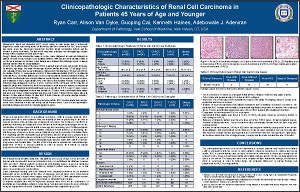Clinicopathologic Characteristics of Renal Cell Carcinoma in Patients 45 Years of Age and Younger
Ryan Carr, Alison Van Dyke, Guoping Cai, Kenneth Haines, Adebowale J. Adeniran
Department of Pathology, Yale School of Medicine, New Haven, CT, USA
ABSTRACT
We have been investigating the roles of PECAM-1, a member of the Ig superfamily of transmembrane proteins, in a variety of in vivo and in vitro models with the goal of elucidating the effects of its alternatively spliced isoforms and polymorphisms on vascular and immune cell behaviors. We have found that PECAM-1 functions as a scaffolding protein, mediating the binding and/or activation of beta- and gamma-catenin, SHP1 & 2, STAT3 & 5, src family members and syk, having a wide range of effects on endothelial cells, polymorphonuclear leukocytes, lymphocytes, megakaryocytes and mononuclear cells.We have been investigating the roles of PECAM-1, a member of the Ig superfamily of transmembrane proteins, in a variety of in vivo and in vitro models with the goal of elucidating the effects of its alternatively spliced isoforms and polymorphisms on vascular and immune cell behaviors. We have found that PECAM-1 functions as a scaffolding protein, mediating the binding and/or activation of beta- and gammacatenin, SHP1 & 2, STAT3 & 5, src family members and syk, having a wide range of effects on endothelial cells, polymorphonuclear leukocytes, lymphocytes, megakaryocytes and mononuclear cells. We have been investigating the roles of PECAM-1, a member of the Ig superfamily of transmembrane proteins, in a variety of in vivo and in vitro models with the goal of elucidating the effects of its alternatively spliced isoforms and polymorphisms on vascular and immune cell behaviors. We have found that PECAM-1 functions as a scaffolding protein, mediating the binding and/or activation of beta- and gamma-catenin, SHP1 & 2, STAT3 & 5, src family members and syk, having a wide range of effects on endothelial cells, polymorphonuclear leukocytes, lymphocytes, megakaryocytes and mononuclear cells.
©2012 Yale Department of Pathology. All rights reserved.
Any redistribution or reproduction of part or all of the contents in any form is prohibited. You may not, except with express written permission of the author or the Department of Pathology, distribute or commercially exploit the content, nor may you transmit it or store it in any other website or other form of electronic retrieval system, including use for educational purposes.
